Monitored Indoor Environmental Quality of a Mass Timber Office Building: A Case Study
Abstract
1. Introduction
2. Materials and Methods
2.1. Indoor Air Quality
2.2. Bacterial Community
2.3. Vertical Vibration
3. Results & Discussion
3.1. Indoor Air Quality
3.2. Bacterial Community
3.3. Vertical Vibration
4. Conclusions
Author Contributions
Funding
Acknowledgments
Conflicts of Interest
References
- ICC (International Code Council). International Building Code; ICC: Falls Church, VA, USA, 2015. [Google Scholar]
- AWC (American Wood Council). National Design Specification for Wood Construction; AWC: Leesburg, VA, USA, 2015. [Google Scholar]
- Arif, M.; Katafygiotou, M.; Mazroei, A.; Kaushik, A.; Elsarrag, E. Impact of indoor environmental quality on occupant well-being and comfort: A review of the literature. Int. J. Sustain. Built Environ. 2016, 5, 1–11. [Google Scholar]
- Mitchell, C.S.; Zhang, J.; Sigsgaard, T.; Jantunen, M.; Lioy, P.J.; Samson, R.; Karol, M.H. Current state of the science: Health effects and indoor environmental quality. Environ. Health Perspect. 2007, 115, 958–964. [Google Scholar] [CrossRef] [PubMed]
- Bard, D.; Vardaxis, N.G.; Sondergard, E. Acoustic Comfort Investigation in Residential Timber Buildings in Sweden. J. Sustain. Archit. Civ. Eng. 2019, 1, 78–89. [Google Scholar]
- Kuusk, K.; Kaiser, A.; Lolli, N.; Johansson, J.; Hasu, T.; Gunnarshaug Lien, A.; Arumägi, E.; Kalbe, K.; Hallik, J.; Kurnitski, J. Energy Performance, Indoor Air Quality and Comfort in New Nearly Zero Energy Day-care Centres in Northern Climatic Conditions. J. Sustain. Archit. Civ. Eng. 2019, 1, 7–16. [Google Scholar]
- Verma, I.; Cronhjort, Y.; Kuittinen, M. Design for care—Use of wood in public buildings. In Proceedings of the WCTE 2016, Vienna, Austria, 22–25 August 2016. [Google Scholar]
- Martins, C.; Santos, P.; Almeida, P.; Godinho, L.; Dias, A. Acoustic performance of timber and timber-concrete floors. Constr. Build. Mater. 2015, 101, 684–691. [Google Scholar] [CrossRef]
- Casagrande, D.; Giongo, I.; Pederzolli, F.; Franciosi, A.; Piazza, M. Analytical, numerical and experimental assessment of vibration performance in timber floors. Eng. Struct. 2018, 168, 748–758. [Google Scholar] [CrossRef]
- Jarnerö, K.; Brandt, A.; Olsson, A. Vibration properties of a timber floor assessed in laboratory and during construction. Eng. Struct. 2015, 82, 44–54. [Google Scholar] [CrossRef]
- Adekunle, T.O.; Nikolopoulou, M. Thermal comfort, summertime temperatures and overheating in prefabricated timber housing. Build. Environ. 2016, 103, 21–35. [Google Scholar] [CrossRef]
- Albatici, R.; Gadotti, A.; Rossa, G.; Frattari, A. Comparison of thermal comfort conditions in multi-storey timber frame and cross-laminated residential buildings. J. Sustain. Archit. Civ. Eng. 2017, 19, 40–48. [Google Scholar] [CrossRef]
- Nyrud, A.; Bringslimark, T.; Englund, F. Wood use in a hospital environment: VOC emissions and air quality. Eur. J. Wood Wood Prod. 2012, 70, 541–543. [Google Scholar] [CrossRef]
- Höllbacher, E.; Ters, T.; Rieder-Gradinger, C.; Srebotnik, E. Influences of interior fitting processes on the indoor air quality of two model rooms. Eur. J. Wood Wood Prod. 2016, 74, 693–701. [Google Scholar] [CrossRef]
- Kembel, S.W.; Jones, E.; Kline, J.; Northcutt, D.; Stenson, J.; Womack, A.M.; Green, J.L. Architectural design influences the diversity and structure of the built environment microbiome. ISME J. 2012, 6, 1469. [Google Scholar] [CrossRef] [PubMed]
- Weckendorf, J.; Toratti, T.; Smith, I.; Tannert, T. Vibration serviceability performance of timber floors. Eur. J. Wood Wood Prod. 2016, 74, 353–367. [Google Scholar] [CrossRef]
- Lever Architecture. Available online: https://leverarchitecture.com/projects/albina_yard (accessed on 14 May 2019).
- Laguerre, A.; Stenson, J.; Van Den Wymelenberg, K.; Gall, E.T. Preliminary investigation of helium diffusion sampling for monitoring of indoor volatile organic compounds. In Proceedings of the Indoor Air 2018, Philadelphia, PA, USA, 22–28 July 2018. [Google Scholar]
- Lindinger, W.; Hansel, A.; Jordan, A. On-Line Monitoring of Volatile Organic Compounds at Pptv Levels by Means of Proton-Transfer-Reaction Mass Spectrometry (PTR-MS) Medical Applications, Food Control and Environmental Research. Int. J. Mass Spectrom. Ion Process. 1998, 173, 191–241. [Google Scholar] [CrossRef]
- Jordan, A.; Haidacher, S.; Hanel, G.; Hartungen, E.; Märk, L.; Seehauser, H.; Schottkowsky, R.; Sulzer, P.; Märk, T.D. A high resolution and high sensitivity proton-transfer-reaction time-of-flight mass spectrometer (PTR-TOF-MS). Int. J. Mass Spectrom. 2009, 286, 122–128. [Google Scholar] [CrossRef]
- Holzinger, R.; Kasper-Giebl, A.; Staudinger, M.; Schauer, G.; Röckmann, T. Analysis of the chemical composition of organic aerosol at the Mt. Sonnblick observatory using a novel high mass resolution thermal-desorption proton-transfer-reaction mass-spectrometer (hr-TD-PTR-MS). Atmos. Chem. Phys. 2010, 10, 10111–10128. [Google Scholar] [CrossRef]
- Chin, K.; Laguerre, A.; Ramasubramanian, P.; Pleshakov, D.; Stephens, B.; Gall, E.T. Emerging investigator series: Primary emissions, ozone reactivity, and byproduct emissions from building insulation materials. Environ. Sci. Process. Impacts 2019. [Google Scholar] [CrossRef] [PubMed]
- Kembel, S.W.; Meadow, J.F.; O’Connor, T.K.; Mhuireach, G.; Northcutt, D.; Kline, J.; Green, J.L. Architectural design drives the biogeography of indoor bacterial communities. PLoS ONE 2014, 9, e87093. [Google Scholar] [CrossRef] [PubMed]
- Callahan, B.J.; McMurdie, P.J.; Rosen, M.J.; Han, A.W.; Johnson, A.J.A.; Holmes, S.P. DADA2: High-resolution sample inference from Illumina amplicon data. Nat. Methods 2016, 13, 581. [Google Scholar] [CrossRef]
- Yilmaz, P.; Parfrey, L.W.; Yarza, P.; Gerken, J.; Pruesse, E.; Quast, C.; Glöckner, F.O. The SILVA and “all-species living tree project (LTP)” taxonomic frameworks. Nucleic Acids Res. 2013, 42, D643–D648. [Google Scholar] [CrossRef]
- DADA2 and Phyloseq Example. Available online: https://github.com/SueIshaq/Examples-DADA2-Phyloseq (accessed on 14 May 2019).
- McMurdie, P.J.; Holmes, S. phyloseq: An R package for reproducible interactive analysis and graphics of microbiome census data. PLoS ONE 2013, 8, e61217. [Google Scholar] [CrossRef] [PubMed]
- Oksanen, J.; Blanchet, F.G.; Friendly, M.; Kindt, R.; Legendre, P.; McGlinn, D.; Solymos, P. Vegan: Community Ecology Package. R package version 2.4–4. 2017. Available online: https://kityna.ga/548893pdf.pdf (accessed on 14 May 2019).
- Love, M.I.; Huber, W.; Anders, S. Moderated estimation of fold change and dispersion for RNA-SEQ data with DESeq2. Genome Biol. 2014, 15, 550. [Google Scholar] [CrossRef] [PubMed]
- Wickham, H.; Chang, W. ggplot2: An Implementation of the Grammar of Graphics. R package version 0.7. 2008. Available online: http://CRAN. R-project. org/package= ggplot2 (accessed on 14 May 2019).
- Bates, D.; Mächler, M.; Bolker, B.; Walker, S. Fitting linear mixed-effects models using lme4. arXiv 2015, arXiv:1406.5823. [Google Scholar]
- Mugabo, I.; Barbosa, A.; Riggio, M. Modal Identification Study of a Four-story Mass-timber Building. In Proceedings of the 2018 World Conference on Timber Engineering (WCTE 2018), Seoul, Korea, 20–23 August 2018. [Google Scholar]
- Murray, T.M.; Allen, D.E.; Ungar, E.E. Floor Vibrations due to Human Activity; AISC Steel Design Guide: Chicago, IL, USA, 1997. [Google Scholar]
- BSI. BS EN 1995-1-1: Eurocode 5: Design of Timber Structures–Part 1-1: General–Common Rules and Rules for Buildings; CEN: Brussels, Belgium, 2004. [Google Scholar]
- Feldmann, M.; Heinemeyer, C.; Lukic, M. Design of Footbridges. Guideline. Human Induced Vibrations of Steel Structure (Hivoss); European Commission JRC: Brussels, Belgium, 2004. [Google Scholar]
- Satish, U.; Mendell, M.J.; Shekhar, K.; Hotchi, T.; Sullivan, D.; Streufert, S.; Fisk, W.J. Is CO2 an indoor pollutant? Direct effects of low-to-moderate CO2 concentrations on human decision-making performance. Environ. Health Perspect. 2012, 120, 1671–1677. [Google Scholar] [CrossRef] [PubMed]
- Allen, J.G.; MacNaughton, P.; Satish, U.; Santanam, S.; Vallarino, J.; Spengler, J.D. Associations of cognitive function scores with carbon dioxide, ventilation, and volatile organic compound exposures in office workers: A controlled exposure study of green and conventional office environments. Environ. Health Perspect. 2016, 124, 805–812. [Google Scholar] [CrossRef] [PubMed]
- NTP (National Toxicology Program). Report on Carcinogens, 15th ed.; U.S. Department of Health and Human Services, Public Health Service: Research Triangle Park, NC, USA, 2016. Available online: https://ntp.niehs.nih.gov/go/roc14 (accessed on 14 May 2019).
- Huang, Y.T.; Chen, C.C.; Chen, Y.K.; Chiang, C.M.; Lee, C.Y. Environmental test chamber elucidation of ozone-initiated secondary pollutant emissions from painted wooden panels in buildings. Build. Environ. 2012, 50, 135–140. [Google Scholar] [CrossRef]
- Kagi, N.; Fujii, S.; Tamura, H.; Namiki, N. Secondary VOC emissions from flooring material surfaces exposed to ozone or UV irradiation. Build. Environ. 2009, 44, 1199–1205. [Google Scholar] [CrossRef]
- World Health Organization. WHO Guidelines for Indoor Air Quality: Selected Pollutants; WHO Regional Office for Europe: Copenhagen, Denmark, 2010. [Google Scholar]
- Nielsen, G.D.; Larsen, S.T.; Wolkoff, P. Re-evaluation of the WHO (2010) formaldehyde indoor air quality guideline for cancer risk assessment. Arch. Toxicol. 2017, 91, 35–61. [Google Scholar] [CrossRef]
- Salthammer, T.; Schwarz, A.; Fuhrmann, F. Emission of reactive compounds and secondary products from wood-based furniture coatings. Atmos. Environ. 1998, 33, 75–84. [Google Scholar] [CrossRef]
- Kesselmeier, J.; Staudt, M. Biogenic Volatile Organic Compounds (VOC): An overview on emission, physiology and ecology. J. Atmos. Chem. 1999, 33, 23–88. [Google Scholar] [CrossRef]
- Dorokhov, Y.L.; Sheshukova, E.V.; Komarova, T.V. Methanol in Plant Life. Front. Plant Sci. 2018, 9, 1623. [Google Scholar] [CrossRef] [PubMed]
- De Gouw, J.A.; Middlebrook, A.M.; Warneke, C.; Goldan, P.D.; Kuster, W.C.; Roberts, J.M.; Fehsenfeld, F.C.; Worsnop, D.R.; Canagaratna, M.R.; Pszenny, A.A.P.; et al. Budget of organic carbon in a polluted atmosphere: Results from the New England Air Quality Study in 2002. J. Geophys. Res. Atmos. 2005, 110, D16305. [Google Scholar] [CrossRef]
- Nazaroff, W.W.; Weschler, C.J. Cleaning products and air fresheners: Exposure to primary and secondary air pollutants. Atmos. Environ. 2004, 38, 2841–2865. [Google Scholar] [CrossRef]
- Truc, V.T.Q.; Kim Oanh, N.T. Roadside BTEX and other gaseous air pollutants in relation to emission sources. Atmos. Environ. 2007, 41, 7685–7697. [Google Scholar] [CrossRef]
- Guo, H.; Lee, S.C.; Li, W.M.; Cao, J.J. Source characterization of BTEX in indoor microenvironments in Hong Kong. Atmos. Environ. 2003, 37, 73–82. [Google Scholar] [CrossRef]
- Leusch, F.; Bartkow, M. A Short Primer on Benzene, Toluene, Ethylbenzene and Xylenes (BTEX) in the Environment and in Hydraulic Fracturing Fluids. Smart Water Research Centre 2010, Griffith University. Available online: https://www.ehp.qld.gov.au/management/coalseam-gas/pdf/btex-report.pdf (accessed on 2 April 2019).
- Meadow, J.F.; Altrichter, A.E.; Kembel, S.W.; Kline, J.; Mhuireach, G.; Moriyama, M.; Green, J.L. Indoor airborne bacterial communities are influenced by ventilation, occupancy, and outdoor air source. Indoor Air 2014, 24, 41–48. [Google Scholar] [CrossRef]
- Wu, T.; Täubel, M.; Holopainen, R.; Viitanen, A.K.; Vainiotalo, S.; Tuomi, T.; Boor, B.E. Infant and adult inhalation exposure to resuspended biological particulate matter. Environ. Sci. Technol. 2017, 52, 237–247. [Google Scholar] [CrossRef]
- Khare, P.; Marr, L.C. Simulation of vertical concentration gradient of influenza viruses in dust resuspended by walking. Indoor Air 2015, 25, 428–440. [Google Scholar] [CrossRef]
- Allen, D.E.; Onysko, D.M.; Murray, T.M. Minimizing Floor Vibration. Applied Technology Council: Redwood City, CA, USA, 1999; Volume 1. [Google Scholar]
- International Organization for Standardization. ISO 2631:2003. Mechanical Vibration and Shock—Evaluation of Human Exposure to Whole Body Vibration; ISO: Geneva, Switzerland, 2003. [Google Scholar]
- International Organization for Standardization. ISO 10137:2007. Bases for Design of Structures--Serviceability of Buildings and Walkways against Vibrations; ISO: Geneva, Switzerland, 2007. [Google Scholar]
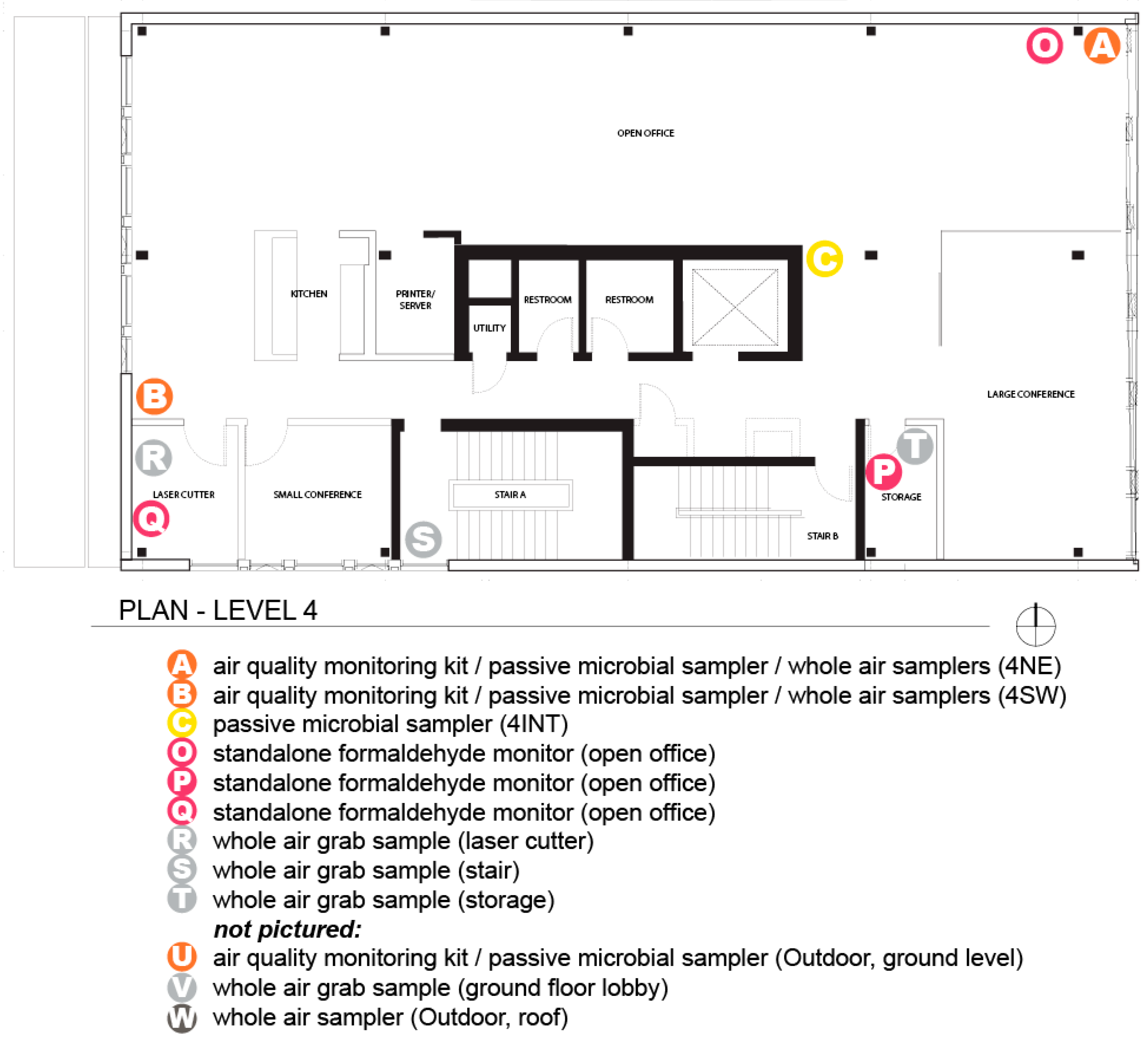
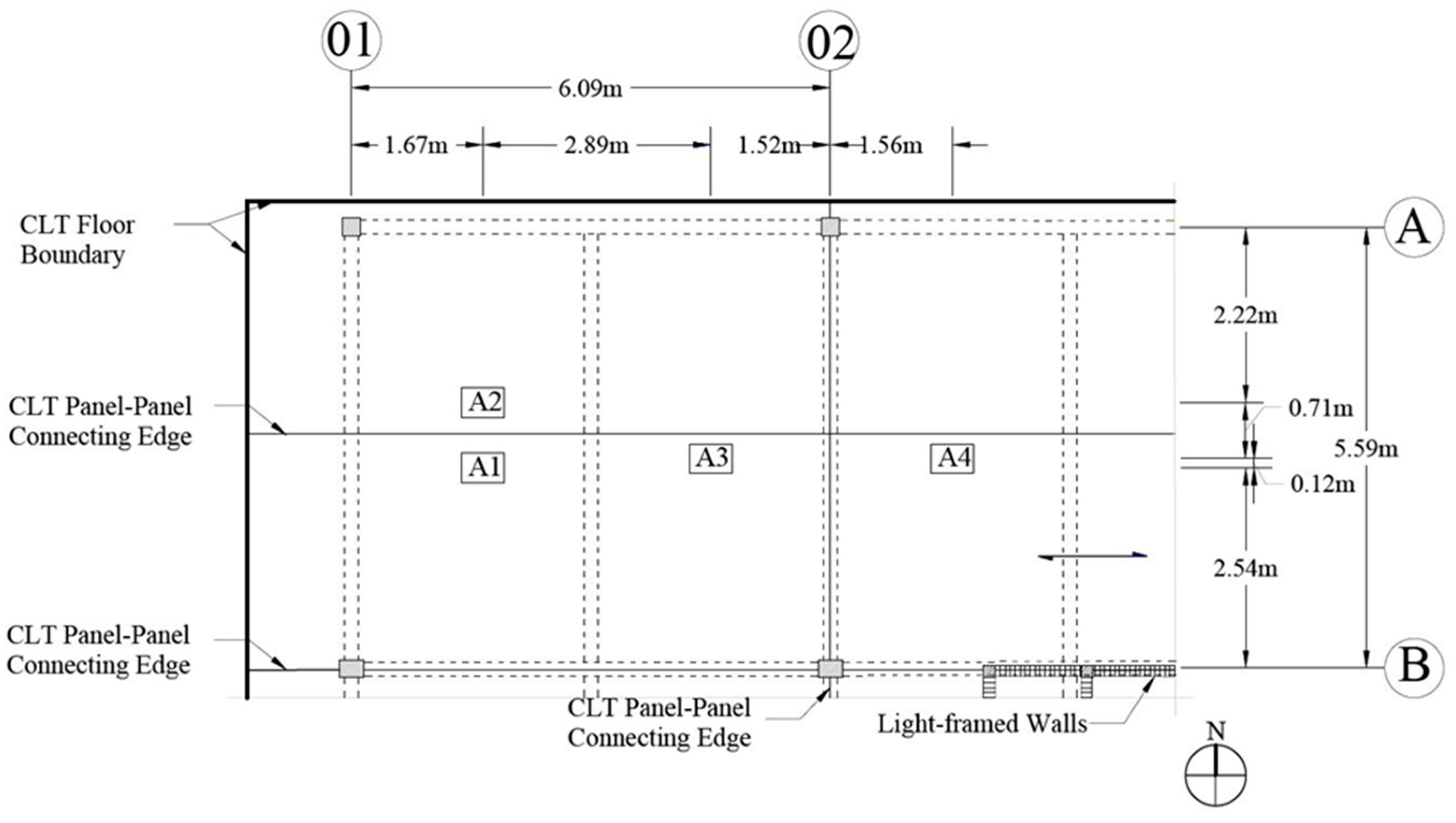
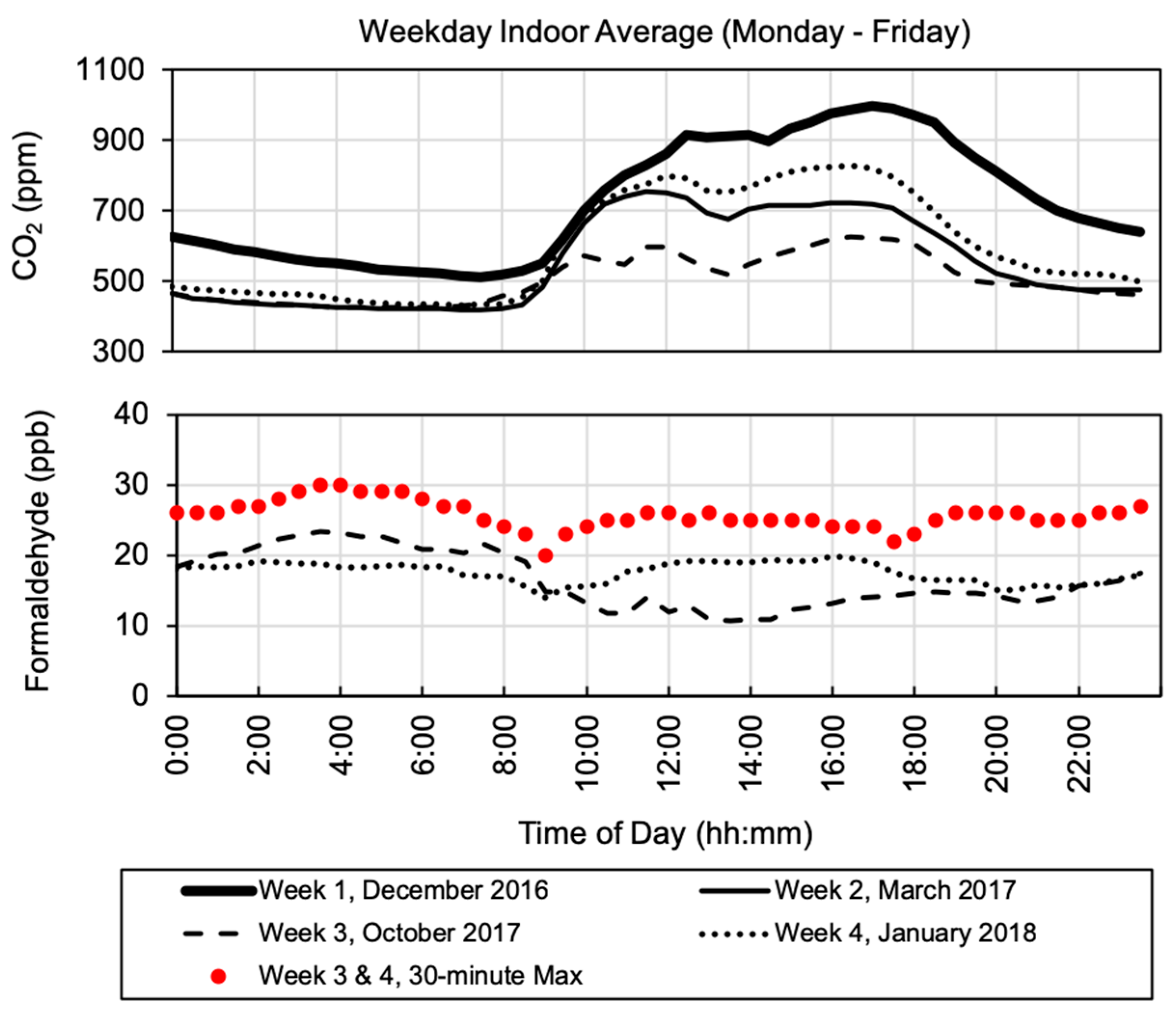

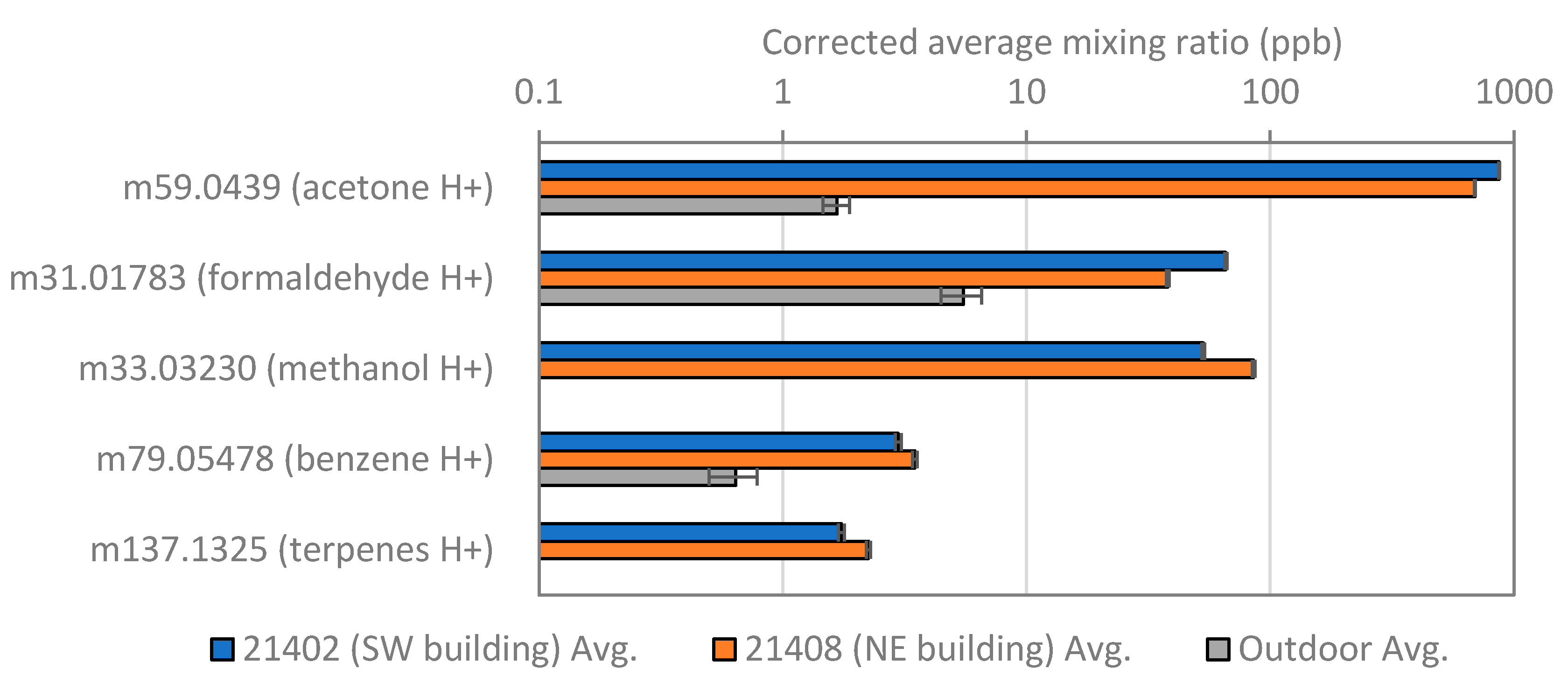
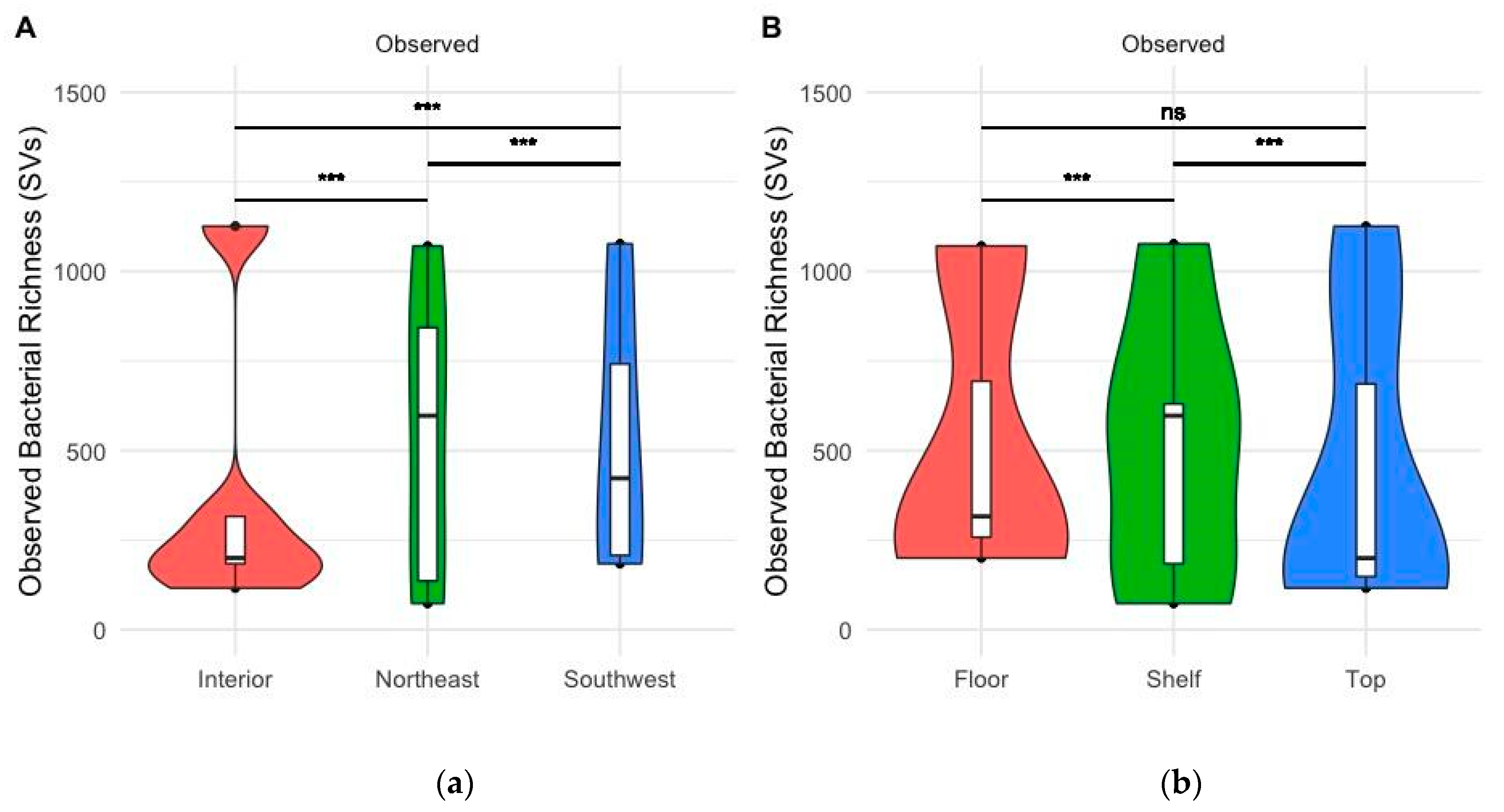
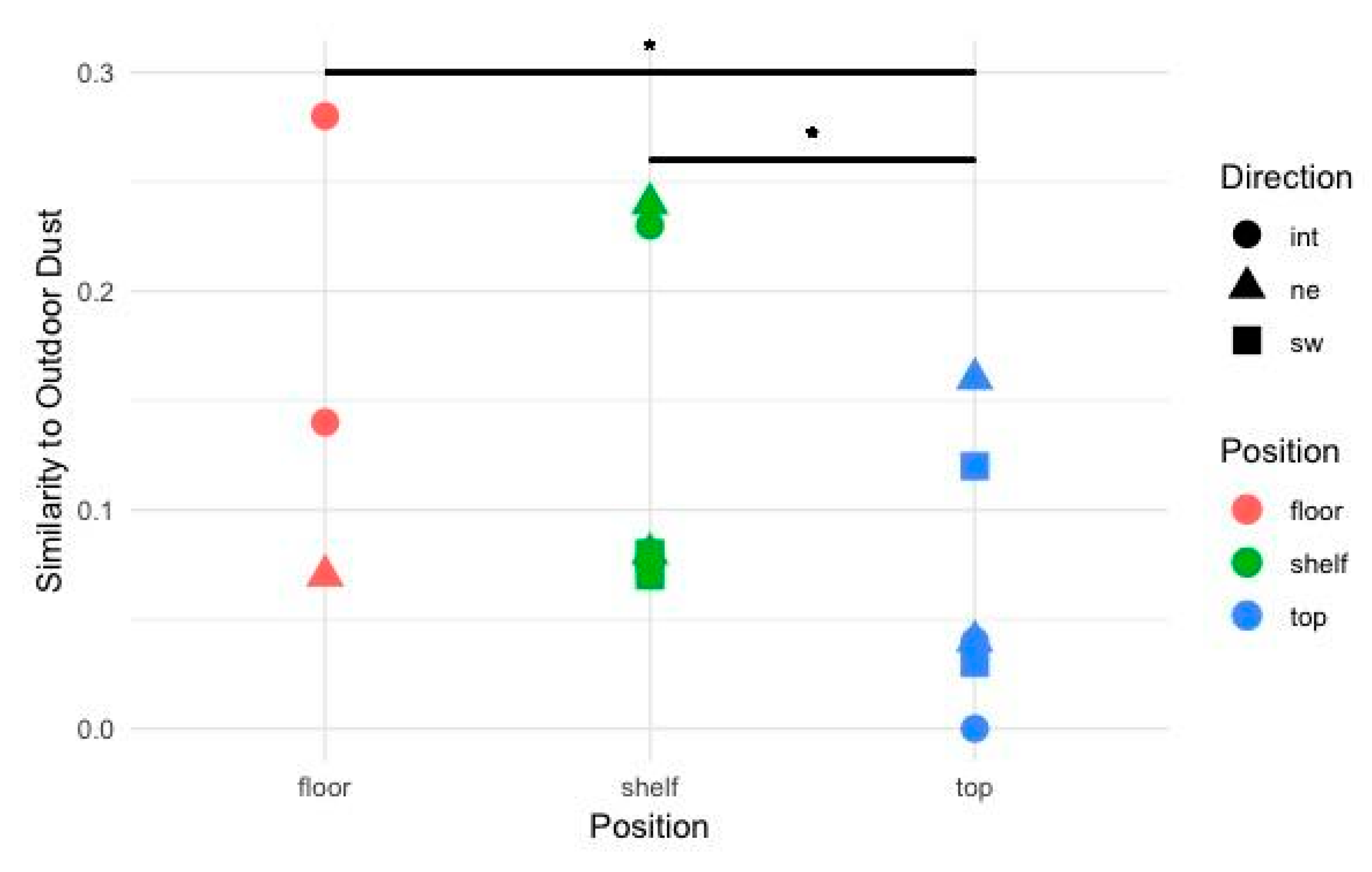
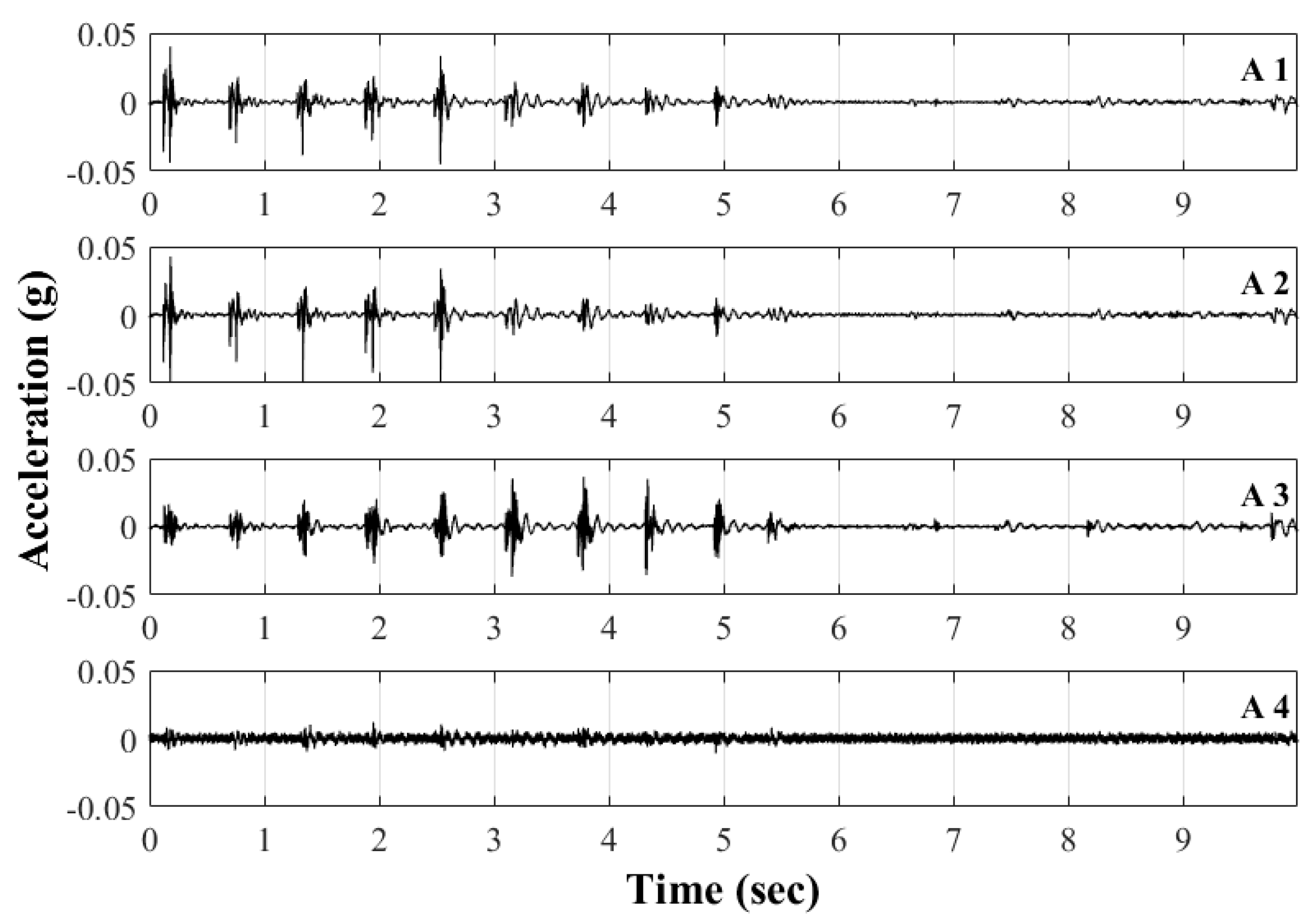

| Make | Model | Parameter(s) |
|---|---|---|
| Entech | BLV1A & HDS-F03 | Bottle-Vac Helium Diffusion Whole Air Sample (1 L) |
| Entech | BLV1A & RS-QTS1 | Evacuated Bottle-Vac Whole Air Grab Sample (1 L) |
| Entech | CS1200ES7 | Evacuated Canister Whole Air Outdoor Sample (6 L) |
| GrayWolf | FM-801 | Formaldehyde (<20–1000 ppb, +/−4 ppb < 40 ppb, +/−10% of reading ≥ 40 ppb) |
| TSI | Velocicalc IAQ Probe 986 | Carbon Dioxide (0–5000 ppm, +/−3% of reading or 50 ppm whichever is greater) |
| Item | Description |
|---|---|
| Accelerometers | 4–PCB 393B04 |
| Data acquisition | 1–NI cDaq 9178 |
| Connectors | 4–BNC cables |
| Data storage | 1–Laptop equipped with NI LabVIEW SignalExpress 2014 |
© 2019 by the authors. Licensee MDPI, Basel, Switzerland. This article is an open access article distributed under the terms and conditions of the Creative Commons Attribution (CC BY) license (http://creativecommons.org/licenses/by/4.0/).
Share and Cite
Stenson, J.; Ishaq, S.L.; Laguerre, A.; Loia, A.; MacCrone, G.; Mugabo, I.; Northcutt, D.; Riggio, M.; Barbosa, A.; Gall, E.T.; et al. Monitored Indoor Environmental Quality of a Mass Timber Office Building: A Case Study. Buildings 2019, 9, 142. https://doi.org/10.3390/buildings9060142
Stenson J, Ishaq SL, Laguerre A, Loia A, MacCrone G, Mugabo I, Northcutt D, Riggio M, Barbosa A, Gall ET, et al. Monitored Indoor Environmental Quality of a Mass Timber Office Building: A Case Study. Buildings. 2019; 9(6):142. https://doi.org/10.3390/buildings9060142
Chicago/Turabian StyleStenson, Jason, Suzanne L. Ishaq, Aurélie Laguerre, Andrew Loia, Georgia MacCrone, Ignace Mugabo, Dale Northcutt, Mariapaola Riggio, Andre Barbosa, Elliott T. Gall, and et al. 2019. "Monitored Indoor Environmental Quality of a Mass Timber Office Building: A Case Study" Buildings 9, no. 6: 142. https://doi.org/10.3390/buildings9060142
APA StyleStenson, J., Ishaq, S. L., Laguerre, A., Loia, A., MacCrone, G., Mugabo, I., Northcutt, D., Riggio, M., Barbosa, A., Gall, E. T., & Van Den Wymelenberg, K. (2019). Monitored Indoor Environmental Quality of a Mass Timber Office Building: A Case Study. Buildings, 9(6), 142. https://doi.org/10.3390/buildings9060142





